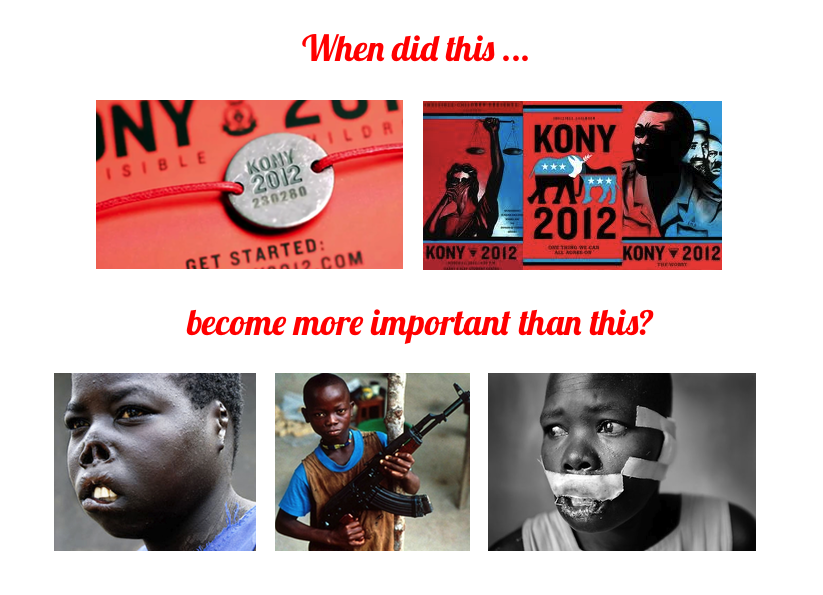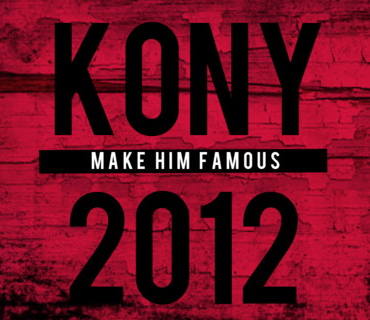Foreword: Sorry I haven't posted a lot, I have been very busy and my favourite camera man is out of town :) As of Monday, business will resume as usual. Today's post is not fashion-related. However, it is an article I have wanted to write for a couple of weeks now and I really hope you will take 5 minutes out of your day to read as I think it is extremely important especially if you have a social presence and authority.
When gimmicks and a glossy viral video trump content Kony 2012 campaign
With todays’ technology, innovative tools and a growing focus on the digital and social spheres, many areas have been transformed from a mere monologue – from politicians, brands, NGOs, SMEs … - to an actual dialogue with their target audience. Clearly a new aspect and huge potential for all involved. However it also means that the audience has a responsibility as it is now actively involved in this new type of dialogue that has been brought about with the emergence of widespread social tools and platforms. Indeed, the audience is no longer just on the receiving end but
The KONY 2012 video hit YouTube 5 March 2012 and has now more than 86 million views and in less than a week became a viral phenomenon in its own league. Now, regardless of whether it is good or bad, the audience of 86 million viewers are responsible for making it the viral video it is now portrayed as. Each and every single person that promoted it - either by sharing it, liking it, tweeting it ... - played a part in its 'sensation' - a sensation that resulted in wrongly educating 86 million people on a specific topic in record time. Something that would make any decent NGO, journalist or teacher cringe.
Just like many, when the Kony 2012 video hit YouTube and Twitter started getting wind of it, I was curious. I forced myself to watch the entire 29:99 minutes of it and once it ended I was at a loss for words. I couldn’t hep but think it was a parody and found the whole ordeal – because yes it was an ordeal to watch - fairly ridiculous, but also genius at the same time. Finally, I came to the conclusion, like many others, that this video is wrong, wrong on so many levels and in so many ways.
The video in undoubtedly genius in the way is narrated, using what is probably the most common storytelling narratives that of the evil man you does really terrible things, most often to innocent and he must be stopped. Personally I watched it till the end because I was curious to see just how far they would take the whole campaign. By the end of the 30minute video, the only things that were actually promoted and subsequently being discussed were:
- "I will buy the Kony pack, I want that bracelet and t-shirt, oh and of course it's all for a good cause",
- "I will take part in the Cover the night event to take place on the 20 April, could be fun",
- "How cute was Jason's kid",
- "We have to stop that Kony guy" …
I was shocked that none of the debates following the Kony video were about the actual content and context, and/or about the real issue at hand. Not that the content was actually even covered in the video, and the small amount that was ended up being flawed or even wrong. The video was more focused on the American side of the story, the 20 April event and Jason's kid, than on the LRA, Kony's victims and their lives.
There is no doubt today that the Kony 2012 campaign has succeeded in terms of visibility – not only has it sparked a global debate surrounding the key figure of the campaign - Kony - but the video subsequently did get everyone to put on their thinking caps and come up with “a better solution” to tackle such humanitarian violations.
The invisible Children organisation stated that the video attempts “to explain the conflict in an easily understandable format, focusing on the core attributes of LRA leadership”. The problem is when such oversimplification is coupled with such a ‘glossy’ campaign focused on gimmicks rather than content, you get many, scratch that you get millions, of misinformed people on board, preaching about a topic they actually no very little about just because it’s a viral buzz.
On 14 March, The Guardian reported that the Kony 2012 video was viewed by those who knew Kony best; his victims in northern Uganda. Their reaction was the right one when faced with the short firm: “puzzlement, then anger, which boiled over into scuffles and stone-throwing that sent organisers fleeing for cover”.
They were perplexed to the idea of making Kony famous. Surely such a criminal does not deserve the fame and attention. And if you want to argue that making him known will help capture him. Then I would argue that making his victims famous is more credible, responsible and sensitive. Surely, “addressing the plight of the victims whose suffering are visible” is the more human way to get people to understand what Kony is capable of. Personally, I find it offensive to popularise a person like Kony. Ask yourself, if you would you walk around with a bracelet baring ‘Hitler’, would you wear a t-shirt with the face of Bin Laden on it, would you feel comfortable chanting the name of Mohamed Merah all in the name of making these people famous so that we better understand their crimes.
Today, weeks after the KONY 2012 video went viral, after the hype surrounding Jason Russell’s - co founder of Invisible Children - odd behaviour and detention by Sand Diego policy, with questions about the financing of Invisible Children being raised, I truly hope people will take a step back and realise that even though the video broke world records with regards to the amount of people that have viewed it, it is a perfect example of how a high-budget viral video can make waves, but not necessarily the good ones. Content and substance is always more important than the tools and format. So please don't get on board something just because it is viral and has celebrity endorsement.
I am looking forward to your comments and thoughts. Contrary to the Invisible Children I will not disable my comments. To the contrary, I look forward to an interesting and meaningful dialogue.
Toni
Read more article on the Kony 2012:
- http://www.guardian.co.uk/world/kony-2012
- http://colorlines.com/archives/2012/03/kony_2012_white_saviors.html
- http://blogs.lse.ac.uk/polis/2012/03/09/why-i-think-the-kony-2012-campaign-is-wrong/
- http://www.time.com/time/nation/article/0,8599,2109314,00.html
Follow me on Bloglovin’ and Twitter


